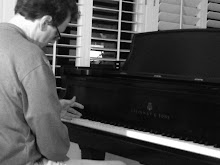Bach Prelude and Fugue No. 4 in C sharp minor, BWV 849
 Relative to San Francisco, it's very quiet here in Fairview, Wyoming, especially in the early spring, as the aspen's don't yet have leaves to rustle in the wind, and the forest birds are just arriving from their winter sojourn. There were no jets flying over the valley this afternoon, and I heard no coyotes -- they only howl at night. However, I did hear Peanut snoring again.
Relative to San Francisco, it's very quiet here in Fairview, Wyoming, especially in the early spring, as the aspen's don't yet have leaves to rustle in the wind, and the forest birds are just arriving from their winter sojourn. There were no jets flying over the valley this afternoon, and I heard no coyotes -- they only howl at night. However, I did hear Peanut snoring again. Amidst this mostly quiet afternoon, and following recordings of the Prelude and Fugue No. 18 in G sharp minor from Bach's Well Tempered Clavier Book 1, I worked on Bach's Prelude and Fugue No. 4 in C sharp minor, also from Book 1. I love the Prelude, so lyrical and inquisitive. A real gem. The Fugue is a tough -- one of the more complex pieces I've studied. I imagine it will take time to truly understand the piece, all of the lines, the five voices in counterpoint, the masterfully developed and contrasting subjects, creating the fugue's austere, tender, yet tormented character. It continues to grow on me.
We always learned in music theory class that you should prepare a dissonant note or chord, perhaps with a suspension, thoughtful voice leading, passing tones, etc. Yet Bach, despite being the reference standard for tonal music theory, doesn't seem to care for such rules and uses unprepared dissonance throughout this fugue, starting with the second note of the subject -- B-sharp, the leading tone, which doesn't resolve to the tonic. True to form, as we encounter the final cadence in bar 112, following a big dominant chord, we get a jarring and once again unprepared dissonant chord. While Bach often uses the Picardy third to end a minor piece in the major key, here he introduces the E-sharp four bars early in a deceptive cadence, an augmented A-major chord (VI7+), first inversion. Not expected. When you look at Bach vertically, to me his music often seems more dissonant than, say, that of Ives. Yet typically, within the context and horizontal flow of the piece, nothing sounds dissonant, as Bach manages to take our ears to many foreign lands that don't seem so foreign. But not this time.
Here is the prelude, followed by the fugue.
Prelude No. 4 in C sharp minor
Fugue No. 4 in C sharp minor



